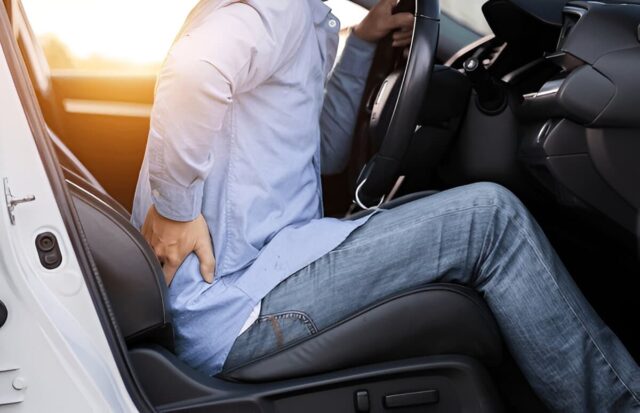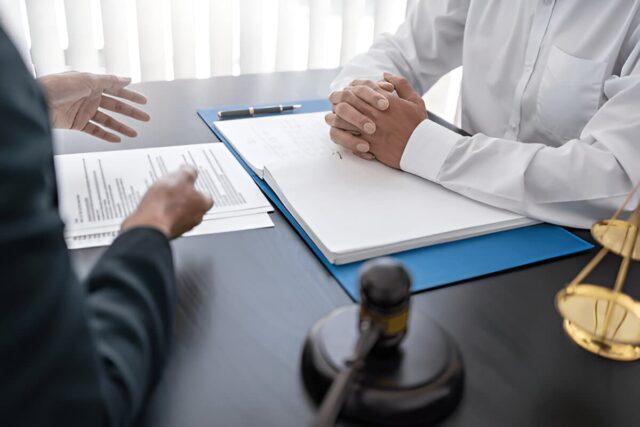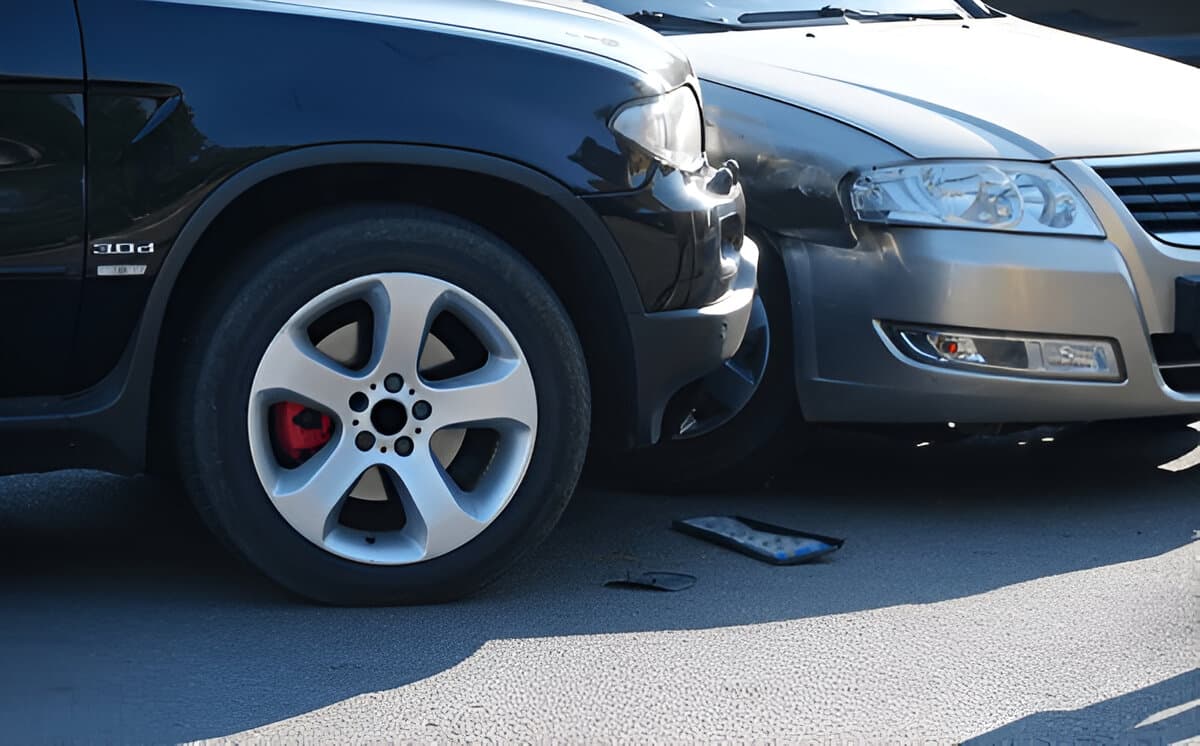The evidence you gather and the steps you take after you get home are how you protect your rights and build a strong foundation for your claim. This is especially true when you’ve been sideswiped while driving, where the details of what happened is so easily disputed.
The process is challenging, as insurance companies may try to assign blame unfairly to minimize their payout.
If a sideswipe accident has left you with injuries and property damage, an Arkansas car accident lawyer can help you pursue the maximum compensation available under the law. Call us for a free consultation at (479) 782-5297.
What Can I Do From Home to Document the Accident?
Your memory is a powerful tool, but it fades. The other driver’s insurance company will be looking for inconsistencies in your story. Writing everything down immediately helps create a reliable record.
Write Down Your Recollection
As soon as you can, write down every detail you remember about the accident. Don’t filter yourself; just get it all on paper. What lane were you in? What was the weather like? What do you remember the other driver doing or saying? Were there any specific landmarks, like signs or businesses, that can help place the event? The more detailed this initial account, the better.
Photograph the Damage (Again)
You may have taken pictures at the scene, which is excellent. Now, take more. At home, in good, even lighting, you can capture details that might have been missed in the rush and poor lighting on the side of the road. Get pictures from multiple angles. Focus on the points of impact, any paint transfer from the other vehicle, and the specific location of the damage on your car. These photos create a visual timeline of the harm done.
Draw a Diagram
You don’t need to be an artist. A simple sketch of the accident scene can be an incredibly effective tool. Draw the road, the lane markings, and the approximate positions of both cars before, during, and after the impact. Use arrows to show the direction of travel. This visual aid clarifies your written description and can make it much easier for an insurance adjuster or jury to understand your perspective.
Should I See a Doctor Even if I Feel Fine?
Following a car wreck, you might feel shaken but otherwise unharmed. The temptation is to just go home and rest, assuming any soreness will pass. This is a significant misstep for both your health and your potential legal claim.
The Hidden Danger of Delayed-Onset Injuries
 The rush of adrenaline your body produces during a stressful event like a car crash is a powerful painkiller. It can mask symptoms of genuine injury for hours or even days. Some of the most common injuries in sideswipe accidents don’t present immediately. These include:
The rush of adrenaline your body produces during a stressful event like a car crash is a powerful painkiller. It can mask symptoms of genuine injury for hours or even days. Some of the most common injuries in sideswipe accidents don’t present immediately. These include:
- Whiplash: A forceful back-and-forth movement can injure the soft tissues in your neck, leading to pain, stiffness, and headaches that appear later.
- Back Problems: The jarring motion can cause herniated discs or aggravate existing back conditions, with pain emerging over time.
- Concussions: Even without a direct blow to the head, the force of the impact can cause your brain to move inside your skull, leading to a concussion with symptoms that might not be immediately apparent.
Creating a Medical Record
When a doctor examines you, they create an official record. This record establishes a direct link between the accident and any injuries you have sustained. If you wait weeks to see a doctor, an insurance company will almost certainly argue that your injury must have been caused by something else that happened in the intervening time.
When you see a healthcare provider, be specific. Tell them you were in a car accident. Describe the impact and how your body moved. Detail every single symptom, no matter how minor it seems at the time—from a slight headache to tingling in your fingers.
Who is Usually at Fault in a Sideswipe Collision?
On the surface, fault in a sideswipe seems straightforward. In most cases, the driver who failed to maintain their lane of travel is the one at fault. This could happen because of an unsafe lane change, drifting while distracted, or overcorrecting after a mistake. The lines painted on the road are there for a reason, and a failure to respect them is a clear failure to operate a vehicle safely.
But the real world is rarely that simple.
The other driver is not likely to admit they drifted into your lane. They will almost certainly have a different story—perhaps that you were the one who veered into them. Without an independent witness or clear video footage, the situation quickly becomes a “he said, she said” scenario. This is where insurance companies see an opportunity to deny or devalue your claim by arguing that you share the blame.
How We Establish the Other Driver’s Negligence
When your account of the accident differs from the other driver’s, we have to prove it. In legal terms, we must demonstrate that the other driver was negligent.
Negligence is a legal framework used to determine fault. It simply means we must show that the other driver had a responsibility to drive safely, that they failed in that responsibility, and that their failure caused your injuries and damages.
The Four Elements We Prove
To build a successful claim, our firm focuses on establishing four distinct elements:
- Duty: Every driver in Arkansas has a legal duty to operate their vehicle with reasonable care. This includes staying within their marked lane unless it is safe to change.
- Breach: The other driver breached this duty. We work to show they made an unsafe lane change, were texting, were speeding, or otherwise acted carelessly.
- Causation: This breach of duty was the direct cause of the sideswipe collision and, consequently, your injuries. We connect their action to your harm.
- Damages: You suffered verifiable losses as a result. These are not just guesses; they are documented medical bills, lost income, vehicle repair costs, and other harms.
We understand the evidence needed to satisfy each of these four elements.
What if the Other Driver Was Texting? Understanding Arkansas’s Distracted Driving Laws
One of the most common reasons a driver drifts from their lane is distraction. And the most prevalent distraction today is the cell phone. Arkansas has taken this danger seriously by enacting specific laws to combat it. The most prominent of these is Paul’s Law, which expressly prohibits all drivers from using a handheld device to text, email, or use social media while driving.
Proving that the other driver was texting at the moment of the crash transforms a case from a word-against-word dispute into a clear demonstration of negligence. However, a driver is not going to volunteer this information. Our firm handles the legal process of issuing subpoenas for the other driver’s cell phone records. These records can show call logs, text message data (times sent and received, not content), and data usage that can pinpoint illegal phone use at the exact time of the collision.
What is “Comparative Fault” and How Does It Affect My Claim?
Insurance companies for the at-fault driver have a specific goal: to pay out as little as possible. In Arkansas, one of their most powerful tools for achieving this is the doctrine of “modified comparative fault.”
In simple terms: this rule acknowledges that sometimes, more than one person is partially to blame for an accident. Under Arkansas law, your total compensation can be reduced by your percentage of fault. For example, if you are awarded $100,000 in damages but are found to be 20% at fault for the accident, your final recovery is reduced by 20%, to $80,000.
The 50% Bar Rule
Here is where the rule becomes particularly harsh. Under Arkansas Code § 16-64-122, if you are found to be 50% or more at fault for the accident, you are barred from recovering any damages. You could have serious injuries and extensive bills, but if you are considered equally responsible, you get nothing from the other party.
This is precisely why, in a sideswipe case, the other driver’s insurer will work so hard to shift even a small amount of blame onto you. They may argue you weren’t paying full attention, that you drifted slightly, or that you failed to take evasive action. If they can convince a jury that you were 50% responsible, their obligation to pay disappears entirely.
The Other Driver’s Insurance Adjuster Called Me. What Should I Do?
It will not take long for the other driver’s insurance adjuster to contact you. They may seem friendly and helpful, expressing concern for your well-being. It is important to remember that this person’s job is not to help you. Their job is to protect their company’s bottom line by scrutinizing your claim.
They will likely ask you to provide a recorded statement about the accident. You are not legally obligated to do this, and it is almost never in your best interest.
- Instead of: Giving a recorded statement where your words can be twisted or taken out of context to imply you admitted fault.
- Try: Politely but firmly declining to provide a statement. You can simply say, “I am not prepared to discuss the details of the accident at this time. I will have my attorney contact you.”
- Instead of: Accepting a quick, lowball settlement offer that they claim is the “best they can do.”
- Try: Stating that you are still assessing the full extent of your damages and will not be discussing settlement figures until you have completed your medical treatment and consulted with a lawyer.
Our firm handles all communications with insurance companies on behalf of our clients. This protects you from their tactics and ensures your rights are not compromised by a seemingly innocent conversation.
What Kind of Damages Can Be Recovered After a Sideswipe?
After being injured in a sideswipe collision caused by another’s carelessness, you have the right to seek compensation for all the ways the crash has affected your life. This compensation, legally referred to as “damages,” is generally broken down into two main categories.
Economic Damages
These are the straightforward, tangible financial losses that come with clear documentation like bills and receipts. Our job is to meticulously gather and calculate every one of these costs. This includes:
- Medical Bills: Every dollar spent on your recovery, from the initial emergency room visit and ambulance ride to surgery, physical therapy, prescription medications, and any anticipated future medical needs.
- Lost Wages: The income you lost from being unable to work while you recovered. This can also include the loss of future earning capacity if your injuries permanently affect your ability to do your job.
- Property Damage: The cost to either repair your vehicle to its pre-accident condition or, if it is declared a total loss, its fair market replacement value.
Non-Economic Damages
These damages compensate for the very real but intangible losses that don’t come with a price tag. They address the human cost of the accident. These may include:
- Pain and Suffering: Compensation for the physical pain, discomfort, and emotional distress caused by your injuries.
- Mental Anguish: For the fear, anxiety, depression, or PTSD that can develop following a traumatic car accident.
- Loss of Enjoyment of Life: If your injuries prevent you from engaging in the hobbies, activities, and family life that you once loved.
Building a case for these damages requires a thorough approach. Our role is to document every aspect of your loss to build a comprehensive demand for the maximum compensation available to you under Arkansas law.
How Long Do I Have to File a Claim in Arkansas?
 The law sets a firm deadline for filing a personal injury lawsuit. This deadline is known as the statute of limitations. In Arkansas, for most personal injury claims stemming from any type of a car accident, the statute of limitations is three years from the date of the accident.
The law sets a firm deadline for filing a personal injury lawsuit. This deadline is known as the statute of limitations. In Arkansas, for most personal injury claims stemming from any type of a car accident, the statute of limitations is three years from the date of the accident.
While three years might sound like a long time, it is a mistake to wait. Building a strong legal case is not something that happens overnight. Over time, physical evidence is easily lost or destroyed, the memories of witnesses fades, and it becomes more difficult to gather the detailed documentation needed to prove your claim. The other side will use any delay to their advantage.
Acting promptly is always the best course of action. Contacting an attorney soon after the accident allows them to begin their investigation while the evidence is still fresh and gives them the necessary time to build the strongest possible case on your behalf.
Frequently Asked Questions About Sideswipe Accidents
What if the other driver fled the scene (hit-and-run)?
If the at-fault driver cannot be identified, you may still have options. Your own insurance policy might include Uninsured Motorist (UM) coverage, which can be used to cover your damages. We will help you review your policy and file a claim with your own insurer.
My car has a lane-departure warning system; does that automatically prove I wasn’t at fault?
Not automatically, but it can be very powerful evidence. Data from your car’s event data recorder (“black box”) combined with the functionality of safety systems like lane-keeping assist can help build a strong technical argument that your vehicle was maintaining its lane properly at the time of impact.
Should I post about my accident on social media?
No. We strongly advise all clients to refrain from posting anything about their accident or their recovery on social media. Insurance companies actively search these platforms for photos, comments, or “check-ins” that they can use to argue that your injuries are not as severe as you claim.
The police report says I’m partially at fault. Is my case over?
Absolutely not. A police report is an officer’s opinion based on their initial observations at a chaotic scene. It is not a final legal determination of fault. We frequently handle cases where the initial police report contains errors or reaches a premature conclusion. Our own investigation can uncover evidence that tells a different story.
What if both drivers claim the other one entered their lane? How is that resolved?
This is the classic sideswipe dilemma. Resolution comes down to evidence. We look for physical evidence like tire marks and the location of debris. We search for overlooked witnesses or nearby surveillance cameras from businesses or homes. We analyze the damage to both vehicles to reconstruct the angle of impact. In these situations, a thorough investigation is what makes the difference.
Let Caddell Reynolds Law Firm Protect Your Rights
A sideswipe accident claim is won or lost in the details. It is a contest of evidence, and you should not let an insurance company dictate the narrative. Our firm has years of experience handling car accident claims across Arkansas. Our Arkansas personal injury attorneys will work tirelessly to investigate your accident, gather the proof needed, and ensure your story is heard and your rights are upheld.
Let us handle the legal process so you can focus on your recovery. For a no-cost, no-obligation evaluation of your case, call Caddell Reynolds Law Firm today at (479) 782-5297.

